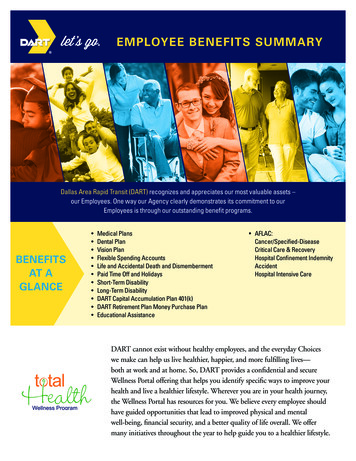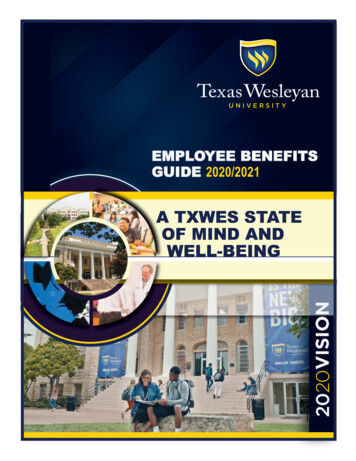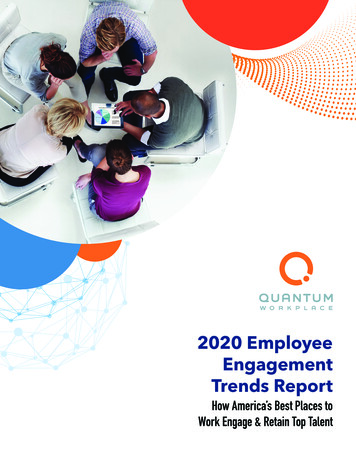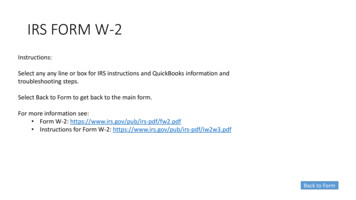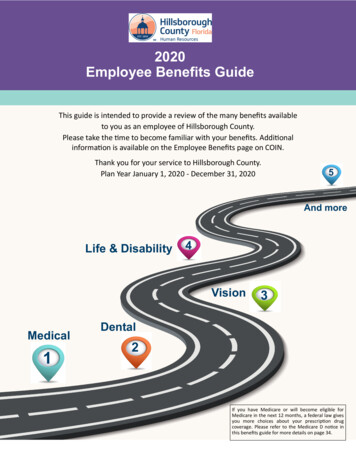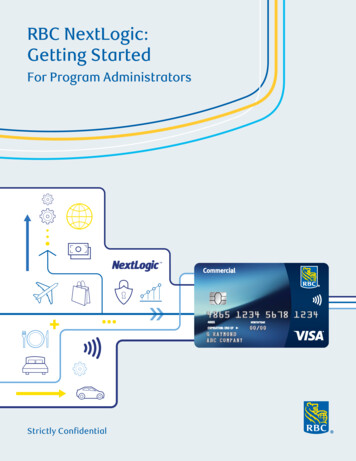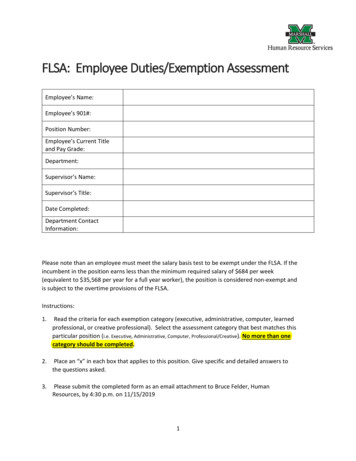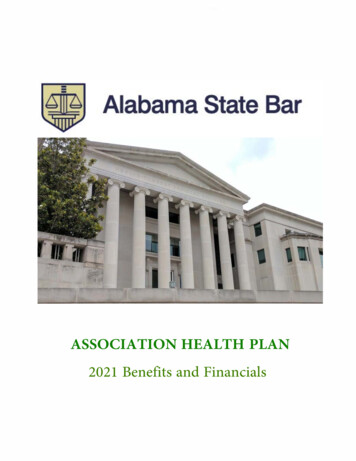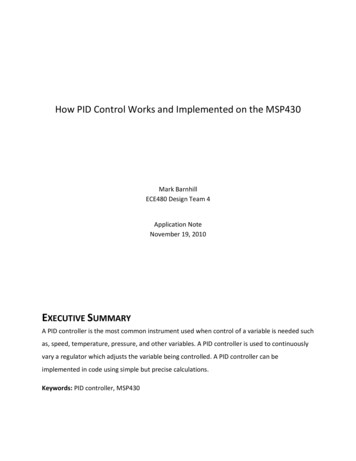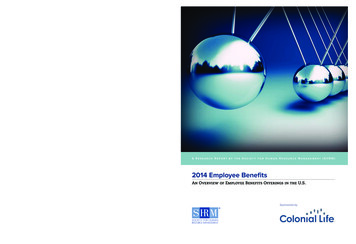
Transcription
2014 Employee BenefitsNow find outwhat trulyMOTIVATESyour workforce.SHRM PEOPLEINSIGHTAn Employee Job Satisfaction& Engagement Survey ServiceAnd we’ll do allthe legwork. An Overview of Employee Benefits Offerings in the U.S.You’ve implementedstrategies to attractand keep the bestemployees.14-0028To schedule a brief demo or to order now, contact us at:shrm.org/peopleinsight 1.703.535.6295 peopleinsight@shrm.orgA Research Report by the Society for Human Resource Management (SHRM)2014 Employee BenefitsAn Overview of Employee Benefits Offerings in the U.S.ISBN 978-1-586-44372-6Sponsored by1800 Duke StreetAlexandria, VA 22314USA14-0301 Beneftis Report CVR.indd 1SHRM Store #: 62.27057 199.95 nonmember 99.95 member6/9/14 12:39 PM
2014 Employee BenefitsA Research Report by the Society for Human Resource Management (SHRM)Media ContactKate Kennedykate.kennedy@shrm.orgPhone 1.703.535.6260Vanessa Grayvanessa.gray@shrm.orgPhone 1.703.535.6072USAAbout SHRMThe Society for Human ResourceManagement (SHRM) is the world’s largestassociation devoted to human resourcemanagement. Representing more than275,000 members in over 140 countries,the Society serves the needs of HRprofessionals and advances the interests ofthe HR profession. Founded in 1948, SHRMhas more than 575 affiliated chapterswithin the United States and subsidiaryoffices in China, India and United ArabEmirates. Visit SHRM Online at shrm.org.SHRM1800 Duke StreetAlexandria, VA 22314Phone 1.800.283.7476Fax 1.703.535.6432Email shrm@shrm.orgChinaSHRM China11th Floor, Building AGateway PlazaNo.18 Xiaguangli, NorthRoad East Third RingChaoyang DistrictBeijing, 100027ChinaTel 86.10.59231033Fax 86.10.59231055Email SHRMChina@shrm.orgIndia605, 6th Floor,Global Business Park, Tower BGurgaon, Sector 26, Haryana 122002IndiaTel 91.12.44200243United Arab EmiratesDubai Knowledge VillageBlock 9 – Ground floorExecutive Office 21PO Box 502221Dubai, UAETel 971.050.104.6330Fax 04.364.9465OnlineSHRM Online shrm.orgSHRM Research shrm.org/researchSHRM Survey Findings shrm.org/surveysSHRM Research on Twitter @SHRM ResearchSHRM Research on LinkedIn LinkedIn.comSHRM Research on SHRM Connecthttp://community.shrm.org/home14-0301To order printed copies of this report, visit shrmstore.shrm.org or call 1-800-444-5006.14-0301 Beneftis Report CVR.indd 26/9/14 12:39 PM
ContentsContentsAbout This Research Report. 1A Message From Colonial Life. 3Executive Summary. 4Survey Results. 8Health Care and Welfare Benefits. 9Preventive Health and Wellness Benefits.16Retirement Savings and Planning Benefits. 19Financial and Compensation Benefits.22Leave Benefits. 28Family-Friendly Benefits.32Flexible Working Benefits.35Employee Programs and Services. 38Professional and Career Development Benefits.41Housing and Relocation Benefits. 43Business Travel Benefits. 46Other Benefits. 48Employee Benefits in Today’s Business Environment.50The Impact of the Economy on Benefits.50Total Employer Costs for Employee Compensation and Benefits.51Reviewing and Analyzing the Benefits Plan.51Methodology.52Respondent Demographics.53Survey ditional SHRM Resources. 74Acknowledgments.77
A b o u t Th i s R e s e a r c h R e p o r t
A b o u t Th i s R e s e a r c h R e p o r tAbout This Research ReportThe following report provides an analysis of the 2014SHRM Employee Benefits Survey results. In February 2014,the Society for Human Resource Management (SHRM)conducted its annual survey to gather information onthe types of benefits employers offer to their employees.The survey instrument listed more than 300 benefitsand asked human resource (HR) professionals to indicate1234567Health care and welfare benefits.Preventive health and wellness benefits.Retirement savings and planning benefits.Financial and compensation benefits.Leave benefits.Family-friendly benefits.whether their organizations offered these benefits. If theHR professional reported that his or her organizationdid not offer the benefit, the respondent was asked ifthere were plans to offer the benefit in the next year.The report is composed of 12 benefits sections as follows:89Employee programs and services.101112Housing and relocation benefits.Professional and career developmentbenefits.Business travel benefits.Other benefits.Flexible working benefits.Each section has two tables in the body of the report.The first table displays the overall percentage of organizations that offer each benefit and the percentage oforganizations that do not offer the benefit now but haveplans to do so within the next 12 months. The secondtable illustrates the percentage of organizations offeringbenefits on an annual basis over a period of five years.A number of benefits have been added, changed ordropped from 2013 to 2014. Forces driving the changesincluded SHRM’s own research of benefits trends, aneed for clarification of some represented benefits,member input, and external research and resources.Some of the new benefits added to this year’s reportinclude divorce insurance, safety bonus/incentives,free snacks and beverages, electric vehicle chargingstations, and company paraphernalia. Edited itemsare footnoted in tables throughout the report.2014 Employee Benefits 1
A dv e r t i s e m e n t2 2014 Employee Benefits
A dv e r t i s e m e n tLike you, we care about our customersTo run a business, you need a combination of pioneerAt no direct cost to you, we provide benefit solutionsspirit, a drive for innovation, the desire to give yourand services, including benefits communication, enroll-best and a commitment to good, hard work. We sharethose qualities. That’s why we design benefit solu-ment solutions and voluntary insurance products.tions, tailored specifically for you to help deal with:Our suite of proven benefit services include: Rising health care costs Cost management strategies Tightening HR resources Complex benefits and administration Time-saving HR and administrative services A benefits communication and engagement system Increasing competition to retain quality employees Financial protection products for your employeesWe don’t just haveproducts – we have solutionsLet us help youFor 75 years, Colonial Life & Accident Insur-We remain dedicated to our mission of findingance Company has had one mission: to helpAmerica’s workers preserve and protect the vitallyimportant things they work so hard to build.ways to help America’s workers when they faceunexpected events and challenging times. Let us putour powerful benefit solutions to work for you.We pioneered marketing voluntary benefits at theworksite in 1955, and we’ve grown to become an industryCall us at 800-845-7330, or visitleader, serving nearly 80,000 businesses just like yours.ColonialLife.com to learn more.
E x e c u t i v e S u m m a ryExecutive Summary
E x e c u t i v e S u m m a ryEmployers Adjust Their Investments inEmployee Benefits, EmphasizingHealth Care and Wellnesswith chronic health conditions, rewards or bonusesfor completing certain health and wellness programs,health care premium discounts for getting an annualhealth risk assessment, health care premium discountsfor not using tobacco products, and health carepremium discounts for participating in a wellnessprogram.External factors are always influencing the types of benefits employers offer. In the past decade, there have beenmany times of uncertainty and economic volatility. Although this makes employee benefits all the more important as a recruitment and retention tool, the rising costsof many of these benefits have made it more challengingfor employers to continue to offer them. These two opposing forces—a strong demand for employee benefits byjobseekers and existing employees alike, and the ongoingrise in the cost of benefits, particularly health insurance—act as a backdrop to many of the trends uncoveredin this most recent 2014 Employee Benefits research report. Retirement savings and planning benefits: The shiftto defined contribution retirement savings plans andRoth 401(k) savings plans continues, with only 24% oforganizations reporting that they now offer definedThe need to maintain key benefits in areas where costsare rising rapidly may mean fewer resources are leftavailable to invest in other kinds of benefits that areless in demand. This need to counterbalance may bethe main reason the latest findings demonstrated anincrease in the percentages of organizations offeringseveral types of health care and wellness benefits, yet adecrease in many other categories of employee benefits.The need to maintain key benefits in areaswhere costs are rising rapidly may meanfewer resources are left available to investin other kinds of benefits that are less indemand.Summary of Findings Health care and welfare benefits: Five-year trends showan increase in the percentage of organizations offeringmental health care coverage, contraception coverage,vision insurance, and coverage for bariatric and laservision surgery. The shifting of health care costs toemployees is most likely behind the 12 percentage pointincrease in the number of organizations offering healthsavings accounts (HSAs) and the 17 percentage pointincrease in the prevalence of employer contributions toHSAs. Meanwhile, there were declines in the percentageof organizations offering retiree health care coverageand health reimbursement arrangements (HRAs). Preventive health and wellness benefits: One of thekey strategies many employers are using to reducehealth care benefits costs is to boost employee healththrough preventive health and wellness benefits. Thepast five years have seen increases in the percentageof organizations offering health and lifestyle coaching,preventive programs specifically targeting employeesbenefit pension plans that are open to all employees.Although more retirement planning and investment riskis shifting onto the employee, several benefits aimed athelping employees make better investment decisionshave actually seen a decline between 2013 and 2014.There have been substantial declines in the number oforganizations offering defined contribution savings planhardship withdrawals and defined contribution planloans, as well as various types of investment advice. Financial and compensation benefits: There were anumber of financial and compensation benefits thatsaw a decline in the percentage of organizations thatoffer them. Between 2010 and 2014, fewer organizationsoffered dependent care flexible spending accounts,undergraduate educational assistance, incentivebonus plans for executives and 529 plans. Between2013 and 2014, there was a decline in the percentage oforganizations offering graduate education assistance.In fact, the only financial benefit that increased wasthe use of spot bonuses/awards. The decline in the2014 Employee Benefits 5
E x e c u t i v e S u m m a rypercentage of organizations offering educationalassistance benefits comes just when many organizationsare reporting increased difficulty in finding jobseekerswith the educational qualifications needed for manyhigh-skilled jobs. The decline in educational benefitsofferings could lead to future skills shortages. Leave benefits: The move toward the use of paid timeoff plans has been the major trend in the categoryof leave benefits. Between 2010 and 2014, there hasbeen an 11 percentage point increase in the number oforganizations offering paid time off plans. Meanwhile,there was a decrease in the percentage of organizationsoffering paid personal days. Family-friendly benefits: There were no significantincreases in the percentage of organizations offeringfamily-friendly benefits, and the survey results revealeda five-year decline in the percentage of organizationsoffering child care and elder care referral services. Flexible working benefits: Other than telecommutingon an ad-hoc basis, which increased from 45% to 54%between 2009 and 2014, most flexible work benefits heldsteady. Employee programs and services: The use of paycards,or payroll debit cards that enable employers to payemployees through payroll direct deposit even if they donot have bank accounts, was the only employee servicebenefit that increased in the past five years. Meanwhile,the percentage of organizations offering postal services,company-sponsored sports teams, travel planningservices and executive club membership all decreasedover the years. Professional and career development benefits:Virtually all professional and career developmentbenefits tracked in the survey declined between 2010and 2014 or within the last year. So although manyorganizations are apprehensive about future skillsshortages, this concern has not yet translated intogreater investments in benefits related to employeeprofessional and career development. Housing and relocation benefits: Housing andrelocation benefits also mainly decreased between2010 and 2014. Most notable were decreases in thepercentages of companies offering temporary relocationbenefits and spouse relocation employment assistance. Business travel benefits: There were few major changesin business travel benefits, with the exception ofreimbursement for personal telephone calls while ontravel, which declined from 54% in 2010 to only 30% in2014.Changes in the Amount of Employer-Sponsored Benefits in the Last Year28%Increased63%Remained the sameDecreased9%Note: n 418. Respondents who answered “not sure” were excluded from this analysis.Source: 2014 Employee Benefits: A Research Report by SHRM6 2014 Employee Benefits
E x e c u t i v e S u m m a ryLooking Ahead Consider the impact of reducing employeeeducational, professional and career developmentbenefits. SHRM research suggests that manyorganizations are having a difficult time filling keypositions that require the most skilled and educatedemployees.1 Yet, at the same time, the 2014 EmployeeBenefits Survey data suggest that many organizationsare cutting back on benefits that would help employeesobtain the education and credentials that wouldmake them more qualified to fill these roles. Thisdisconnect could be the result of several factors: thecost of education is growing too high for employersto continue to support education as a benefit, othercompeting costs (especially health care) are taking upa bigger share of benefits budgets, or these types ofbenefits, from the employers’ perspective, do not havea high enough return on investment. Regardless of thereason, this trend poses a significant potential futurechallenge. If employers need skilled and educatedemployees, yet they decrease their investment ineducation and development benefits, it only standsto reason that filling positions of most strategicimportance will grow even more difficult in the future. Ensure compliance with all laws relating to benefits,especially the Patient Protection and Affordable CareAct (PPACA). HR professionals have played a leading rolein ensuring that their organizations fully comply withthe numerous requirements of the PPACA. As variouscomponents of the law go into effect, HR professionalswill continue to lead their organizations through thecomplexities of the legislation and will help them createstrategies to deal with the impact the law has on theirorganization’s health care benefits. In addition to thePPACA, HR professionals will continue to take the leadin ensuring legal compliance with all laws relating toemployee benefits. Promote flexible and effective work arrangements.Data from a number of SHRM employee job satisfactionsurveys show that workers from many differentdemographic groups and job levels highly value flexiblework arrangements.2 With many benefits costs rising,work-flex benefits represent a possible low-cost way tostand out from other potential employers. In addition,with the Millennials now joining the labor market infull force and many Baby Boomers looking to downshiftprior to full retirement, the demand for these benefitsis likely to be greater than ever. Furthermore, the agingworkforce may signal managing multiple caregivingresponsibilities for workers, requiring flexible workarrangements.3With many benefits costs rising, work-flexbenefits represent a possible low-costway to stand out from other potentialemployers. Improve employee benefits communication efforts.SHRM research on the state of employee benefitsindicates that many organizations are not fullyleveraging their benefits programs to attract andretain the best and the brightest.4 Communicatingthe value of employee benefits effectively couldthus make a real difference to the bottom line. Theuse of total compensation statements, benefitsworkshops, employee meetings and self-servicebenefits technologies can help enhance employees’understanding of the value of the benefits offered by theorganization. Continuously obtain feedback on the effectivenessof benefits in recruiting and retaining employees.The workforce is constantly evolving, and these shiftsinfluence how employees perceive their benefits plans.The marketplace is also constantly undergoing change,so benefits programs must be regularly assessed tomake sure that employees understand the value oftheir benefits packages and that the organization isremaining competitive in the marketplace. The use ofbenchmarking tools, benefits needs assessments andemployee surveys may become even more widespreadas technology helps make them more accessible andcost-effective.2014 Employee Benefits 7
S u r v e y R e s u lt sSurvey Results
H e a lt h C a r e a n d W e l fa r e B e n e f i t sHealth Care and Welfare BenefitsTable A-1: Health Care and Welfare BenefitsCurrently Offer the BenefitPlan to Offer the Benefit inthe Next 12 MonthsPrescription drug program coverage95%0%Dental insurance95%1%Mental health coverage87% 1%Mail-order prescription program84% 1%Preferred provider organization (PPO)84%0%Accidental death and dismemberment insurance (AD&D)A84%0%Contraceptive coverage84% 1%Vision insurance83% 1%Chiropractic coverage83% 1%Employee assistance program (EAP)74%2%A74%1%Short-term disability insuranceA70%1%Medical flexible spending accountsB68%1%Supplemental accident insurance46% 1%Health savings account (HSA)45%4%Bariatric coverage for weight loss38%1%Acupressure/acupuncture medical coverage36% 1%Health maintenance organization (HMO)33%0%Long-term disability insurance32%1%32%2%Consumer-directed health care plan (CDHP)30%3%Critical illness insuranceD30%1%Health care premium flexible spending accountCEmployer contributions to HSAsInfertility treatment coverage other than in-vitro fertilization29% 1%Laser-based vision correction coverage28% 1%In-vitro fertilization coverage26% 1%Long-term care insurance24%1%Hospital indemnity insurance22% 1%Point of service (POS) plan22% 1%2014 Employee Benefits 9
H e a lt h C a r e a n d W e l fa r e B e n e f i t sTable A-1: Health Care and Welfare Benefits (continued)Currently Offer the BenefitPlan to Offer the Benefit inthe Next 12 MonthsIntensive care insurance21% 1%Retiree health care coverage18% 1%Health reimbursement arrangement (HRA)17%1%Wholesale generic drug program for injectable drugs16%1%Elective procedures coverage15% 1%14%1%FAlternative/complementary medical coverage14%1%Indemnity plan (fee-for-service)12% 1%Gender reassignment surgery coverage7% 1%Exclusive provider organization (EPO)7%1%Experimental/elective drug coverage4% 1%Mini-med health plan2%1%Pharmacy management programG(n 470-508)ADoes not pertain to employee-paid supplemental insurance.BIRC Section 125.CIRC Section 125 Cafeteria Plan allowing for premium conversion.DProvides funds to help cover extra expenses upon diagnosis of a critical illness or condition.EProvides funds to help cover the extra expenses for accidents or illnesses that result in an admission to a hospital intensive care unit.FAny nonemergency surgical procedure other than laser-based vision correction coverage.GIndependent of medical plan management.Source: 2014 Employee Benefits: A Research Report by SHRMPrescription Drug CoverageOne of the most commonly offered health care andwelfare benefits was prescription drug program coverage: 95% of organizations offered this benefit to theiremployees. Eighty-four percent offered a mail-orderprescription program, through which employees can savemoney on medication by filling prescriptions throughlicensed pharmacies and having them convenientlydelivered through the mail at a discounted rate. Otherbenefits related to prescription drug coverage includedwholesale generic drug programs for injectable drugs(16%) and pharmacy management programs (14%).Health Insurance ProgramsAt 98%, nearly all organizations offer some type ofhealth care coverage to their full-time employees.The most frequently offered type of health insurance was a preferred provider organization (PPO)plan, offered by 84% of respondents’ organizations.These plans offer a network of health care providersthat patients must use or otherwise pay more forservices from providers outside of the network.Health savings accounts (HSAs) were created bythe Medicare bill in 2003 and are designed to helpindividuals save on a tax-free basis for future qualified medical and retiree health care costs. Forty-fivepercent of organizations provided these accounts.Contributions to HSAs can be made by the employer,10 2014 Employee Benefitsthe employee or both. Thirty-two percent of organizations made contributions to these accounts.98%, nearly all organizations, offer sometype of health care coverage to their fulltime employees.One-third (33%) of organizations offered health maintenance organization (HMO) plans, which require participants to choose a primary care physician from theirnetwork to coordinate all of the patient’s care. A pointof service (POS) plan, offered by 22% of organizations,is a unique managed care health insurance system thatcombines attributes from both HMOs and PPOs. Exclusiveprovider organizations (EPOs) are self-funded medicalplans that combine aspects of a PPO and an HMO. EPOsoffer a certain level of benefits if care is provided by a specific network of service providers; otherwise, no paymentis made. Overall, 7% of organizations offered this plan.Indemnity, or fee-for-service, plans are thought of as moretraditional health care plans, which charge employees foreach individual service and allow employees completechoice in which providers they see. Twelve percent oforganizations reported offering this type of plan.
H e a lt h C a r e a n d W e l fa r e B e n e f i t sSeventeen percent of organizations offered healthreimbursement arrangements (HRAs). These health carespending accounts are set up by the employer for theemployee, and the employer makes contributions forthe employee to use for health care services. HRAs aresimilar to flexible spending accounts, except that theemployer may permit funds to roll over from year to year,allowing the employee to accumulate funds over time.Consumer-directed health care plans (CDHPs) generallyinclude three major components: an HRA or HSA, an underlying medical plan, and access to educational tools andinformation to help members navigate the plan. Almostone-third (30%) of organizations reported offering a CDHP.Mini-med health plans are limited-benefit indemnity medical plans. They can vary widely, butare typically distinguished by low premiums andlow payment caps. These plans usually appeal toorganizations with high staff turnover or manyhourly and part-time workers. Only 2% of organizations reported offering mini-med health plans.The vast majority of organizations (95%) offereddental insurance to employees, and more thanfour-fifths (83%) offered vision insurance. Theseprograms may be offered either as part of or in addition to other health insurance plans.Other forms of insurance offered by respondents’ organizations include accidental death and dismembermentinsurance (84%), chiropractic coverage (83%), supplemental accident insurance (46%), critical illness insurance(30%), long-term care insurance (24%), hospital indemnityinsurance (22%) and intensive care insurance (21%).Women’s HealthSome organizations offer health care and wellnessbenefits that focus on childbearing and fertility. The mostcommonly offered benefit was contraceptive coverage(84%). In addition, 29% of organizations provided infertility treatment coverage other than in-vitro fertilization(IVF), and 26% specifically offered IVF coverage.Flexible Spending AccountsMedical flexible spending accounts allow employees todeduct pretax dollars from their paychecks to pay forhealth care services, such as co-payments, insurance deductibles, and vision and dental expenses. These accountsoffer organizations a way to help employees manage theirhealth care costs. The maximum amount each eligibleemployee may contribute to these accounts is determinedby the employer. Sixty-eight percent of organizationsoffered medical flexible spending accounts (IRC Section125, for all expenses), and 32% reported offering healthcare premium flexible spending accounts (IRC Section125 Cafeteria Plan allowing for premium conversion).DisabilityLong-term disability (offered by 74% of organizations) andshort-term disability (offered by 70% of organizations)provide income replacement for employees whose illnessor injury causes absence from work. Short-term disabilityusually starts after a one- to two-week absence, andlong-term disability usually goes into effect after six to 12weeks. While paid sick leave usually covers an employee’sentire salary, short-term and long-term disabilitymay cover only a portion of the employee’s salary.Mental and Emotional HealthSome organizations offer health and welfare benefits thatare directed toward employees’ mental and emotionalwell-being. The majority (87%) of organizations offeredmental health coverage to their employees. An employeeassistance program (EAP) is a confidential counselingprogram designed to assist employees with any problemsthat may distract them from their work. Approximatelythree-quarters (74%) of organizations offered an EAP.Other Health Care and Welfare BenefitsSome employers include nontraditional healing methodsamong their health and welfare benefits. More thanone-third (36%) of organizations offered acupressure/acupuncture medical coverage, 14% offered otheralternative/complementary medical coverage, and 4%covered experimental or elective drug treatments.Other health care and welfare benefits included bariatriccoverage for procedures such as stomach stapling orgastric bypass surgery (38%), laser-based vision correctioncoverage (28%), health care coverage for retirees (18%),elective procedures coverage (any nonemergency surgicalprocedure other than laser-based vision correction)(15%) and gender reassignment surgery coverage (7%).Health Care and Welfare Benefits Over TimeTable A-2 shows the percentage of organizations offering specific health care and welfare benefits from 2010through 2014. Mail-order prescription programs andlong-term insurance were the two benefits offered byfewer organizations in 2014 compared with 2013 and2010. The number of organizations providing prescriptiondrug program coverage decreased within the past year. Inaddition, health care premium flexible spending accounts,retiree health care coverage and health reimbursementarrangements decreased in the last five years. However,a number of health care and welfare benefits offeringshave increased over time. The following benefits wereoffered by more organizations in 2014 than in 2010:mental health coverage, contraceptive coverage, visioninsurance, health savings accounts, bariatric coveragefor
kate.kennedy@shrm.org Phone 1.703.535.6260 Vanessa Gray vanessa.gray@shrm.org Phone 1.703.535.6072 USA SHRM 1800 Duke Street . vision insurance, and coverage for bariatric and laser
